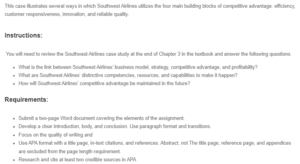Southwest Airlines’ Competitive Advantage
Southwest Airlines is one of the most outstanding performers in the US’s airline industry. The airline has managed to stay ahead of its US rivals due to the low fares it charges its customers relative to competitors. Southwest Airlines manages to charge lower fares due to its low-cost structure. Even though it charges low fares, Southwest Airlines still manages to attain higher profitability relative to its competitors. The airline’s efficiency, outstanding customer service, innovative culture, and high-quality services have given it a competitive edge and earned it profit in bad and good times.
The Link between Southwest’s Business Model, Strategy, Competitive Advantage, and Profitability
Southwest Airlines pursues a low-cost business model. To achieve this, it uses the point-to-point flying strategy and lands in smaller airports while flying passengers. As a result, passengers’ travel time is reduced significantly, thus reducing the cost of flying per passenger (Hill et al., 2020). Besides, passengers themselves prefer this method since they reach their destinations quicker. This model represents a stark difference between American Airlines and Delta, airlines that route passengers through flying hubs (Hill et al., 2020). This business model helps Southwest Airlines boost demand and keep its planes full. Another strategy geared toward reducing costs at Southwest is flying only one type of plane, the Boeing 737. As a result, the cost of staff training, maintenance, and inventory is significantly reduced. The strategy aligns with Walmart’s low-cost strategy, which includes placing low-cost advertisements to reduce costs (Chekwa et al., 2014). Later, the low cost is transferred to the final customer through reduced prices.
Based on the above strategies, Southwest Airline’s competitive advantage is based on cost leadership. A cost leadership strategy requires the sale of a “no-frills, or standard” product or service to consumers. To attain a competitive advantage, a firm should pursue aggressive, tight, and overhead control (Datta, 2010). By only purchasing Boeing 737 planes, it is clear that Southwest Airlines is committed to attaining a low-cost structure from the outset. Due to the company’s aggressive low-cost strategy, Southwest Airlines has attained profitability for 40 consecutive years. The company is an envy in an industry characterized by bankruptcies. Since 1978, over 180 bankruptcies have occurred in the US airline industry, but Southwest Airlines continues to make profits (Hill et al., 2020). Even during the 2001-2005 period, when every other company in the airline industry made losses, Southwest Airlines still managed to make profits.
Southwest Airlines’ Distinctive Competencies, Resources, and Capabilities
One of Southwest Airlines’ distinctive resources is its employee productivity. High employee productivity leads to fewer employees per passenger. The high employee productivity helps keep costs down since the wage bill is low. To ensure that the company hires the best employees, Southwest filters and absorbs only 3% of its candidates annually (Hill et al., 2020). While at it, the HR department focuses on a positive attitude and teamwork as the fundamental employee characteristics leading to employment. Davis (2019) emphasizes the need for employee training as a strategy for enhancing productivity. As such, Southwest Airlines focuses on employee training and upskilling since, during the hiring process, the company considers soft skills only.
Maintaining Competitive Advantage
Southwest Airlines, just like any other airline company, must maintain its set of competitive advantages to stay on top. Southwest Airlines’s competitive advantage is based on innovation, low cost, and efficient operations. The airline should continue focusing on cost reduction as its primary competitive advantage. Subsequently, this will require the company to continue innovating new ways of reducing costs, especially during times of economic downturn.
Conclusion
In summary, Southwest Airlines is a leader in the US airline industry. The company’s competitive advantage is based on its innovativeness, operational efficiency, and low-cost structure. To achieve the low-cost business model (the main competitive advantage), Southwest Airlines operates a point-to-point flying strategy, reducing passengers’ flying time. Also, by flying one plane model, the Boeing 737, Southwest Airlines maintains a low operational cost. Another factor that has helped the company gain a competitive edge over rivals is the high employee productivity, which saves the company on wages.
References
Chekwa, E., Martin, J., & Wells, K. (2014). Riding on the waves of sustained competitive advantage: Consumers’ perspectives on Walmart Corporation. International Journal of the Academic Business World, 8(2), 13-25.
Datta, Y. (2010). A critique of Porter’s cost leadership and differentiation strategies. Chinese Business Review, 9(4), 37.
Davis, P. J. (2019). Training employees to be a source of sustained competitive advantage. The Journal of Applied Business and Economics, 21(5), 29-39.
Hill, C. W., Schilling, M. A., & Jones, G. R. (2020). Strategic management: An integrated approach: Theory and cases (13th ed.). Cengage Learning.
ORDER A PLAGIARISM-FREE PAPER HERE
We’ll write everything from scratch
Question

Southwest Airlines’ Competitive Advantage
This case illustrates several ways in which Southwest Airlines utilizes the four main building blocks of competitive advantage: efficiency, customer responsiveness, innovation, and reliable quality.
Instructions:
You will need to review the Southwest Airlines case study at the end of Chapter 3 in the textbook and answer the following questions:
- What is the link between Southwest Airlines’ business model, strategy, competitive advantage, and profitability?
- What are Southwest Airlines’ distinctive competencies, resources, and capabilities to make it happen?
- How will Southwest Airlines’ competitive advantage be maintained in the future?
Requirements:
- Submit a two-page Word document covering the elements of the assignment.
- Develop a clear introduction, body, and conclusion. Use paragraph format and transitions.
- Focus on the quality of writing and
- Use APA format with a title page, in-text citations, and references. Abstract, not The title page, reference page, and appendices are excluded from the page length requirement.
- Research and cite at least two credible sources in APA

